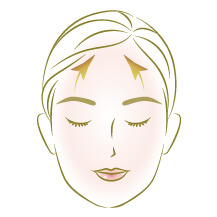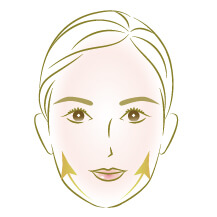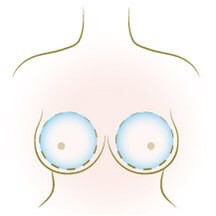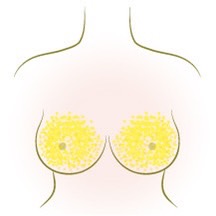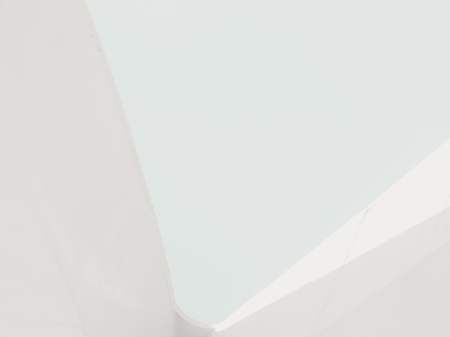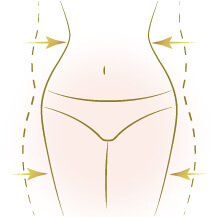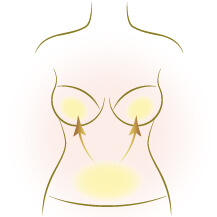Eye Surgery
Lower Blepharoplasty Surgery
BLEPHAROPLASTY
BLEPHAROPLASTY
Lower Blepharoplasty
Surgery
- Principle
- Before and After
- Case Study
Tear through surgery and eye bags are extremely distinct from one another! Four different therapy modalities are frequently discussed.
Dr. Hung-Chang Chen noted that there are significant variances in the most effective treatments and surgical techniques depending on the various patient situations regarding additional eye bags and tear troughs. He is used to categorizing patients into 4 types, each with a different treatment approach, based on his own clinical experience:
Type 1: The patient has no apparent eye bags and simply tear troughs (most of these patients are younger). To improve, one merely needs to accept the autologous fat filling for the midface and tear trough.
Type 2: Visible bags beneath the eyes and tear troughs are present. You will require autologous fat filling of the mid-face and tear troughs, as well as excision of the inward-opening eye bags.
Type 3:The patient has evident tear troughs, bags under the eyes, lax lower eyelids, and creases. Such patients require removal of loose skin under the eyelids along with autologous fat filling of the tear trough and midface.
Type 4: The lower eyelids of these individuals hang loosely over their faces like curtains and they are typically older patients. Such patients need the tear trough and center of the face filled, as well as a significant amount of loose skin under the eyelashes removed.
Type 1: The patient has no apparent eye bags and simply tear troughs (most of these patients are younger). To improve, one merely needs to accept the autologous fat filling for the midface and tear trough.
Type 2: Visible bags beneath the eyes and tear troughs are present. You will require autologous fat filling of the mid-face and tear troughs, as well as excision of the inward-opening eye bags.
Type 3:The patient has evident tear troughs, bags under the eyes, lax lower eyelids, and creases. Such patients require removal of loose skin under the eyelids along with autologous fat filling of the tear trough and midface.
Type 4: The lower eyelids of these individuals hang loosely over their faces like curtains and they are typically older patients. Such patients need the tear trough and center of the face filled, as well as a significant amount of loose skin under the eyelashes removed.

| Surgical Methods | Type 1 | Type 2 | Type 3 | Type 4 |
|---|---|---|---|---|
| Suitable Candidate | 1.Only tear trough and midface depression | 1.The center of the face has a depression and tear troughs. 2. Clearly visible eye bags | 1.A depression in the. midface and tear trough 2.Clearly visible. eye bags 3.Wrinkles and sagging of the lower eyelids | 1.A depression in the midface and tear trough 2.Wrinkles and sagging of the lower eyelids |
| Treatment Methods | 1. Fat Grafting | 1. Fat Grafting 2.Remove an appropriate amount of eye bags through the conjunctiva | 1.Fat Grafting 2.Remove an appropriate amount of eye bags through the conjunctiva 3.Remove loose lower eyelid under eyelashes | 1.Fat Grafting 2.Removal of loose lower eyelid under eyelashes |
| Surgery Time | 1 hour | 1-2 hour | 2 hour | 1-2 hour |
| Anesthesia Method | Local anesthesia | Local anesthesia | Local anesthesia | Local anesthesia |
| Recovery Period | 7-14 days | 7-14 days | 7-14 days | 7-14 days |
| Close to Natural Look | 2-3 months, or more | 2-3 months, or more | 2-3 months, or more | 2-3 months, or more |
Surgical Steps
Step 1: Fat Grafting
Fat grafting has a number of important uses.
1. Correct any soft tissue deficiency (tear trough and midface)
2. Apply a thin layer of fat beneath the muscles and skin to further smooth things out (similar to facial concealer, and wall filling effect)
3. The transplanted fat contains adipose stem cells. Stem cells are undifferentiated, primitive cells with “regeneration” and “differentiation” abilities. It also goes by the names “anti-aging” and “rejuvenation.” Depending on the anatomical makeup of the lower eye, fat grafting is separated into four subregions, each of which has the ideal amount of fat grafting, in Dr. Chen’s experience. To prevent clumps and calcifications brought on by excess fat, the fat grafting procedure will be performed utilizing a sophisticated fat supplement gun with many layers and equal distribution.
Fat grafting has a number of important uses.
1. Correct any soft tissue deficiency (tear trough and midface)
2. Apply a thin layer of fat beneath the muscles and skin to further smooth things out (similar to facial concealer, and wall filling effect)
3. The transplanted fat contains adipose stem cells. Stem cells are undifferentiated, primitive cells with “regeneration” and “differentiation” abilities. It also goes by the names “anti-aging” and “rejuvenation.” Depending on the anatomical makeup of the lower eye, fat grafting is separated into four subregions, each of which has the ideal amount of fat grafting, in Dr. Chen’s experience. To prevent clumps and calcifications brought on by excess fat, the fat grafting procedure will be performed utilizing a sophisticated fat supplement gun with many layers and equal distribution.

Step 2: Open the inside to eliminate eye bags
The three types of fat (inner, middle, and outside) that produce eye bags will be appropriately removed through a 2 cm cut in the conjunctiva.
The three types of fat (inner, middle, and outside) that produce eye bags will be appropriately removed through a 2 cm cut in the conjunctiva.

Step 3: Trim the lower eyelashes and the hanging lower lid.
To remove extra loose skin, surgical incisions are made at the bottom edge of the eyelashes. The lower eyelid muscle (orbicularis) is neither cut or removed; only the skin is removed. The following are benefits of maintaining the lower eyelid muscles:
1. Can prevent the development of muscle scarring
2. Prevent facial nerve damage that could cause inadequate tension in the lower eyelid. This can significantly lessen the likelihood of eyelid retraction and ectropion following surgery (exposed whites, lower three whites). After the procedure, the sutures can dissolve and absorb on their own, but Dr. Chen will remove any sutures that haven’t broken down after roughly a week.
1. Can prevent the development of muscle scarring
2. Prevent facial nerve damage that could cause inadequate tension in the lower eyelid. This can significantly lessen the likelihood of eyelid retraction and ectropion following surgery (exposed whites, lower three whites). After the procedure, the sutures can dissolve and absorb on their own, but Dr. Chen will remove any sutures that haven’t broken down after roughly a week.

Dr. Hung-Chang Chen continued by saying that under typical conditions, the first two types of therapies hardly ever result in facial scarring. However, if it is type 3 or type 4, a 3 cm scar will be left behind the lower eyelid’s eyelashes since the loose skin under the eyelashes needs to be excised during treatment. Fortunately, the lower
Preoperative Preparation and Anesthesia
1.Before surgery, please let your doctor know if you have any drug
allergies.
2.Anticoagulant medication must be stopped one week before to surgery in order to prevent intraoperative and postoperative bleeding.
3.Smoking should be avoided for at least two weeks before to and following surgery.
4.It is advised that medical professionals regulate and stabilize systemic disorders such as excessive blood pressure, heart disease, diabetes, abnormal thyroid function, etc. before undergoing surgery.
6.Please let your doctor know before surgery if you or anybody in your family has swollen feet or hypertrophic scars. Because the patient’s eyes must frequently cooperate during the procedure to ensure precise symmetry, it is advised to do eyelid surgery while the patient is under local anesthetic.
2.Anticoagulant medication must be stopped one week before to surgery in order to prevent intraoperative and postoperative bleeding.
3.Smoking should be avoided for at least two weeks before to and following surgery.
4.It is advised that medical professionals regulate and stabilize systemic disorders such as excessive blood pressure, heart disease, diabetes, abnormal thyroid function, etc. before undergoing surgery.
6.Please let your doctor know before surgery if you or anybody in your family has swollen feet or hypertrophic scars. Because the patient’s eyes must frequently cooperate during the procedure to ensure precise symmetry, it is advised to do eyelid surgery while the patient is under local anesthetic.
Recovery process and post-operative care
1.To lessen discomfort and bruising, it is advised to apply ice for 10
minutes every hour for the first 5-7 days following eyelid surgery.
2.For three days following surgery, prophylactic oral antibiotics, anti-inflammatory, analgesic, detumescence, and other medications will be administered.
3.To replace the dressing, eye ointment will be prescribed by eyelid wound care. Once each in the morning and evening, change your clothes. Clean the site with normal saline or boiled water, remove any scabs or secretions, and then apply fresh ointment.
4.A week following the procedure, the sutures will be taken out.
5. It is advised to warm the skin (to the temperature of face wash water in the morning in winter) for 10 minutes every hour after the stitches are removed to hasten the healing of bruises.
6.Each person’s level of postoperative swelling and bruising is different. It usually becomes apparent three to four days following surgery, and most people can feel better approximately two weeks later.
7.After the procedure, you can wash your face as usual, take a bath, dry your skin right away, and then apply the ointment. But refrain from swimming, wading in the stream alongside the sea, and taking a dip in the hot springs.
8.After surgery, stay away from strenuous activities like hard training, running, mountaineering, rock climbing, etc. It may raise blood pressure, result in bleeding, or leave wounds open.
9.The diet is generally healthy, but stay away from alcohol, smoke, and spicy food (too spicy and salty)
2.For three days following surgery, prophylactic oral antibiotics, anti-inflammatory, analgesic, detumescence, and other medications will be administered.
3.To replace the dressing, eye ointment will be prescribed by eyelid wound care. Once each in the morning and evening, change your clothes. Clean the site with normal saline or boiled water, remove any scabs or secretions, and then apply fresh ointment.
4.A week following the procedure, the sutures will be taken out.
5. It is advised to warm the skin (to the temperature of face wash water in the morning in winter) for 10 minutes every hour after the stitches are removed to hasten the healing of bruises.
6.Each person’s level of postoperative swelling and bruising is different. It usually becomes apparent three to four days following surgery, and most people can feel better approximately two weeks later.
7.After the procedure, you can wash your face as usual, take a bath, dry your skin right away, and then apply the ointment. But refrain from swimming, wading in the stream alongside the sea, and taking a dip in the hot springs.
8.After surgery, stay away from strenuous activities like hard training, running, mountaineering, rock climbing, etc. It may raise blood pressure, result in bleeding, or leave wounds open.
9.The diet is generally healthy, but stay away from alcohol, smoke, and spicy food (too spicy and salty)
Sequelae and Complications
1.Asymmetry is the most frequent side effect of eyelid surgery, and
some individuals require revision surgery.
2.There is a danger of infection, hemorrhage, inadequate wound healing, etc. with any operation.
3.Although all surgeries leave scars, the plastic surgeon will meticulously stitch and use extremely thin sutures to tuck the scars into the creases of the skin and the borders of the hair, making them less noticeable and more difficult to locate. Even so, the scar may still be momentarily red and elevated (1-2 months after the operation) until it stabilizes, but after two to six months the scar will often gradually fade and become less noticeable.
2.There is a danger of infection, hemorrhage, inadequate wound healing, etc. with any operation.
3.Although all surgeries leave scars, the plastic surgeon will meticulously stitch and use extremely thin sutures to tuck the scars into the creases of the skin and the borders of the hair, making them less noticeable and more difficult to locate. Even so, the scar may still be momentarily red and elevated (1-2 months after the operation) until it stabilizes, but after two to six months the scar will often gradually fade and become less noticeable.







